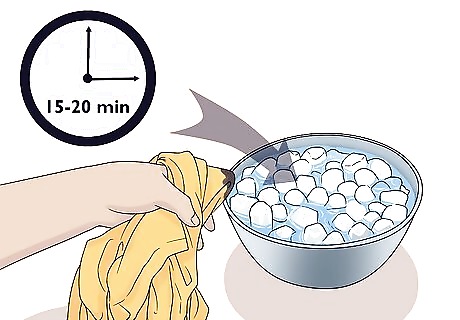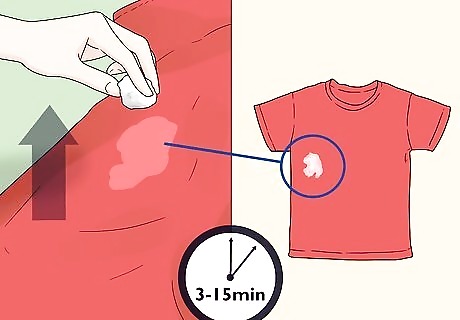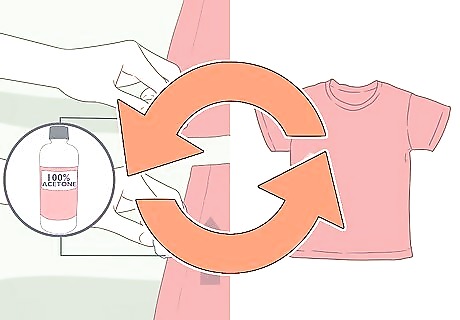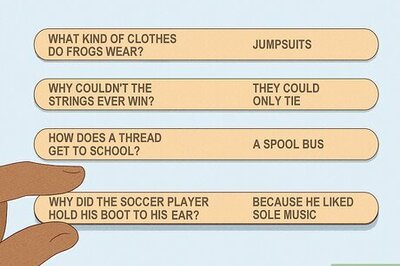
views
- Wait for the glue to dry completely, then scrape off as much as you can with the edge of a spoon.
- If glue remains, apply acetone or nail polish remover to the stain with a cotton ball.
- For extra stubborn glue, apply a laundry stain remover and run the item through the washer like normal.
Scraping the Glue Off

Wait 15-20 minutes for the super glue to dry on its own. Be patient and let the glue dry fully before you attempt to remove it. If you try to tackle the glue while it’s still wet, you may spread it onto more of the fabric or push it deeper into the fibers of the garment. Definitely avoid speeding up the drying process with something like a hair dryer or the heat may permanently set the stain. The glue is dry when it’s no longer soft to the touch and doesn’t feel tacky. Only try to remove dried glue. It seems counterintuitive to let it sit without trying to clean it up, but trying to remove wet glue almost always produces a worse mess.

Soak the stained area in iced water if you don’t have time to let it dry. Fill a bowl with cool water, then add enough ice cubes to make it cold. Dip the stained area into the water for a few seconds, then pull it out. The iced water will have caused the glue to harden. If there’s a large amount of glue or if the glue was designed to be slow-drying, you may need to soak the stain for several minutes or even overnight to fully harden it.

Scrape as much of the glue off as possible with a dull edge. Place the garment on a hard surface, then scrape the glue off with your fingernail, the edge of a spoon, a credit card, or a butter knife. You may not be able to get 100% of the super glue off, but you should be able to get most of the larger chunks off. Do not scrape loosely woven fabric, such as a knit or muslin, or you'll risk tearing it. Instead, skip ahead to Soaking the Glue in Acetone. If large pieces of glue are still stuck to the garment and can’t be scraped off, you will need to dissolve them with acetone. For shoes, bags, or hardy fabrics like denim or canvas, scraping may be sufficient to remove the stain completely.

Check the care tag and take delicate fabrics to a dry cleaner. If the label says “dry clean only” or if the fabric is very delicate (like sheers, lace, or silk), take the garment to a professional to avoid damaging the fabric accidentally. Dry cleaners own specialty products that can safely remove the glue from your fabric. Scraping, acetone, and washing may work for most fabrics, but it can destroy delicates.
Soaking the Glue in Acetone

Test the garment with a few drops of acetone in an inconspicuous area. Moisten a cotton ball with 100% acetone, then press it against a small, hidden spot on the garment, like a hem or seam. Wait a few seconds, then pull the cotton ball away to check for discoloration. If you don't notice any discoloration or disintegration, use acetone to remove the glue. Acetone is generally safe for fabrics like cotton, denim, canvas, and polyester. If you do notice any discoloration or disintegration, stop, rinse the area with water, and take the garment to a dry cleaner to have the glue removed. Do not use acetone on fabrics made from acetate, modacrylic, triacetate, or fine natural fibers like silk. Use acetone in a well-ventilated area to avoid inhaling excess fumes. Buy 100% acetone in hardware stores, or use nail polish remover with acetone as an alternative. If you’re using nail polish remover, make sure it is clear (tinted removers may discolor your clothes).

Press a cotton ball soaked in acetone against the super glue stain. Soak a fresh cotton ball with more 100% acetone. Hold it against the stain with moderate pressure, making sure that you avoid the other parts of the garment (this will help minimize potential damage). If the stain is very large, begin pressing at the outside edges and work your way in toward the center. The acetone will begin to dissolve the bonds of the glue, softening it and making it easier to remove. Acetone is the best solvent for super glue. Rubbing alcohol, which is effective for epoxy-based adhesives, and white vinegar may also work but will take longer to break down the glue. WD-40 is also effective at removing super glue (especially oil-based adhesives), but may leave a stain of its own on the fabric if it spreads too far or sits too long on the garment. Use WD-40 the same way you’d use acetone.

Continue applying acetone until the glue softens and breaks down. Leave your acetone-soaked cotton to sit on the stain, checking on the glue every few minutes. How long it takes for the glue to soften depends on how much glue there is, the exact chemical makeup of the glue, and the fabric. It may take anywhere from 3 to 15 minutes to soften enough to remove.

Scrape the softened glue off with a dull edge. Once again, use your fingernail or the edge of a spoon, card, or butter knife to scrape the glue off. Work slowly to avoid damaging the fabric. Scraping the softened glue may spread it slightly, but since the acetone has saturated it and broken the adhesive bonds, it likely won’t stick to any new areas of fabric. Do not use your fingernail if you are wearing nail polish. The area is soaked in acetone now, which can dissolve the polish and stain the garment.

Repeat the acetone process if layers of super glue remain. While powerful, acetone can only remove a few upper layers of the glue at a time. If you still see large chunks of glue, soak another cotton ball in acetone and repeat the process. You may have to repeat this several times. When almost all of the glue is gone, prepare to run your garment through the washing machine. Scraping and acetone are effective for any type of super glue, including brands like Gorilla Glue, Loctite, Krazy Glue, and more.
Washing the Garment

Apply a laundry pretreatment stain remover to the stain. Once most of the stain is gone, apply a stain remover (or a dab or your regular laundry detergent, in a pinch) to the garment according to the product’s instructions. Massage the product deep into the stain, then rinse the stain with cold water.

Wash the garment using the cycle and temperature listed on the care tag. This will remove any final residue stuck to the fabric. Most garments can be washed in warm or cool water. If your garment no longer has the care tag, use cool water and a gentle cycle to be safe. If you do not have time to do the laundry, hand wash the affected area with cool water and soap. Rinse the area, then pat it dry with a towel.

Wash the garment again if the stain remains. If the stain is very light, run it through the washer a second time (that may be all that is needed to get rid of it for good). If the stain is still visible after a second wash, repeat the acetone treatment again to dissolve more glue away. Do not put the garment into the dryer if the stain is still there. The heat will permanently set the stain into the fabric. If you don’t have time to wash the item again, hang it to air dry and run it through the machine again later.

Hang or machine dry the garment once the stain is completely gone. If you’re unsure whether the glue is completely gone, air dry the item and check for the stain once it’s dry. If you’re 100% certain the glue is completely gone, it’s safe to use the dryer (just make sure there’s absolutely no residue left, or the heat will set the stain). If the stain remains, try applying more acetone and washing the garment again. If it still won’t budge, take the item to a dry cleaner.

















Comments
0 comment